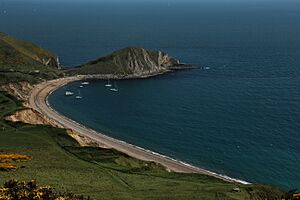Worbarrow Bay facts for kids
Worbarrow Bay is a beautiful, wide, and shallow bay located on the Isle of Purbeck in Dorset, England. It sits just to the east of the famous Lulworth Cove.
Contents
Where is Worbarrow Bay?
Worbarrow Bay is found about 6 kilometers (about 4 miles) south of Wareham and about 16 kilometers (about 10 miles) west of Swanage.
Key Features of the Bay
- Worbarrow Tout: This is a rocky headland at the eastern end of the bay. A headland is a piece of land that sticks out into the sea.
- Cow Corner: This is the name for the northwest part of the bay.
- Flower's Barrow: This ridge rises high above Worbarrow Bay to the north. Over time, parts of Flower's Barrow are slowly falling into the sea because of coastal erosion. Coastal erosion is when the sea wears away the land.
How to Visit Worbarrow Bay
Worbarrow Bay is part of the Lulworth Ranges, which is a military training area. This means you can only visit the bay when the ranges are open to the public.
To get there, you can walk about 1.4 kilometers (just under a mile) down an easy path. This path starts from a car park near the ghost village of Tyneham. The people who lived in Tyneham and Worbarrow had to leave their homes in 1943 because the area was needed for military training. Today, there's not much left of the old cottages and a coastguard station that once stood near the bay.
What is the Geology of Worbarrow Bay?
The rocks and cliffs at Worbarrow Bay tell an amazing story about Earth's past! The geology here is very similar to nearby Mupe Bay, almost like a mirror image.
Layers of Rock in the Cliffs
The cliffs behind Worbarrow Bay show different layers of rock from the Cretaceous period. This period was between 85 and 145 million years ago!
- At Cow Corner, you can see chalk rocks.
- Towards the east, the rocks are much harder. These include Portland limestones, which are about 150 million years old, and the Purbeck Beds, which are 147 million years old.
How the Rocks Were Formed
The rocks in the cliffs and at Worbarrow Tout have cool, angled layers. These layers show how the rocks were folded and twisted about 30 million years ago. This happened because huge landmasses, like the African and European continents, slowly pushed against each other. This pressure caused the rock layers to bend and fold. That's why the younger chalk rocks are found further back in the bay, while the older rocks face the sea at the front.
Fossils at Worbarrow Bay
Worbarrow Bay is part of the famous Jurassic Coast, which is known for its many important fossil discoveries.
The rocks here, especially the Purbeck limestones and shales, are a great place to find fossils. You can even find dinosaur footprints! There are also lots of fossils of creatures that lived in brackish water (a mix of fresh and salt water), such as:
- Bivalves: These are creatures with two shells, like clams.
- Gastropods: These are snails.
- Ostracods: These are tiny crustaceans, like very small shrimp, with a shell.
Images for kids






